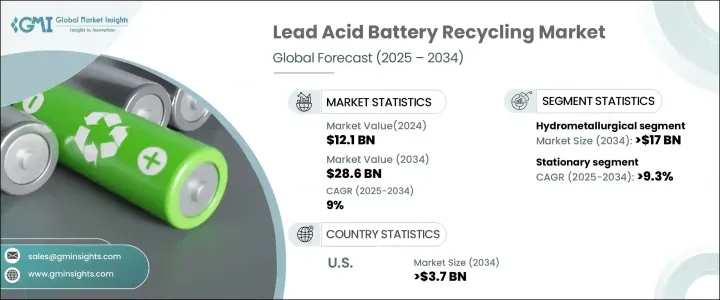
|
市場調査レポート
商品コード
1684672
鉛蓄電池リサイクル市場の機会、成長促進要因、産業動向分析、2025年~2034年予測Lead Acid Battery Recycling Market Opportunity, Growth Drivers, Industry Trend Analysis, and Forecast 2025 - 2034 |
||||||
カスタマイズ可能
|
|||||||
| 鉛蓄電池リサイクル市場の機会、成長促進要因、産業動向分析、2025年~2034年予測 |
|
出版日: 2025年01月12日
発行: Global Market Insights Inc.
ページ情報: 英文 105 Pages
納期: 2~3営業日
|
全表示
- 概要
- 目次
鉛蓄電池リサイクルの世界市場は、2024年に121億米ドルとなり、2025年から2034年までのCAGRは9%と予測され、大幅な成長が見込まれています。
このダイナミックな市場の中心は、使用済み鉛蓄電池(ULAB)の回収と処理で、鉛、硫酸、プラスチックなどの必須材料を回収します。リサイクル工程では通常、電池部品の解体、鉛とその化合物の抽出、硫酸の中和、プラスチックケーシングの再利用が行われます。産業界が持続可能性を優先する中、効果的なリサイクルソリューションの重要性はますます高まっており、この市場は世界の環境戦略の重要な要素となっています。

バッテリーの不適切な廃棄に伴う環境リスクに対する意識の高まりは、市場拡大の主な要因です。鉛と硫酸は、責任を持って管理されなければ、土壌や水を深刻に汚染し、長期的な生態学的・健康上の危険をもたらす可能性があります。リサイクルはこうした危険を軽減し、エネルギー集約的で環境破壊的な性質で知られる鉛の新規採掘の必要性を最小限に抑えます。鉛やプラスチックなどの貴重な素材を再利用することで、リサイクル工程はさらに世界の持続可能性の目標に沿ったものとなります。政府の規制が強化され、より環境に優しい方法を求める消費者の声が高まる中、鉛蓄電池リサイクルの採用は世界中で加速しています。
| 市場範囲 | |
|---|---|
| 開始年 | 2024 |
| 予測年 | 2025-2034 |
| 開始金額 | 121億米ドル |
| 予測金額 | 286億米ドル |
| CAGR | 9% |
湿式冶金プロセスは、2034年までに170億米ドルを生み出すと予測され、業界のゲームチェンジャーとして台頭しつつあります。顕著な環境的・経済的利点を提供するこの方法は、鉛や、コバルトやニッケルのような他の貴重な金属の効率的な回収を保証します。エネルギー効率とコスト効率と相まって、その高い材料収量は、リサイクル施設に広く採用される原動力となっています。業界が持続可能で高収率のリサイクル方法に傾倒しているため、今後数年間は湿式冶金プロセスが主流になると予想されます。
再生鉛蓄電池の据置型用途は、信頼性の高いエネルギー貯蔵ソリューションに対する需要の増加により、2034年までCAGR 9.3%で堅調に成長します。これらのバッテリーは、バックアップパワーシステムや、太陽光・風力エネルギー貯蔵を含む再生可能エネルギー用途に不可欠です。バッテリーのライフサイクルの延長とコスト効率の高いプロセスを保証する高度なリサイクル技術の開発が、据置型アプリケーションでの採用を後押ししています。電池リサイクルの技術革新が進むにつれ、メーカーはより多くのリサイクル材料を製品に組み込むようになり、業界の成長をさらに後押ししています。
米国では、鉛蓄電池リサイクル市場は2034年までに37億米ドルを生み出すと予測されています。この成長を支えているのは、責任ある電池廃棄とリサイクルを義務付ける厳しい環境規制です。特にバックアップ電源や再生可能エネルギーの統合など、住宅、商業、工業の各分野でエネルギー貯蔵ソリューションの需要が高まっていることが、市場拡大に拍車をかけています。こうした動向は、電池リサイクル分野で持続可能性と効率的な資源利用が重視されるようになっていることを浮き彫りにしています。
目次
第1章 調査手法と調査範囲
- 市場の定義
- 基本推定と計算
- 予測計算
- 1次調査と検証
- 一次情報
- データマイニングソース
- 市場定義
第2章 エグゼクティブサマリー
第3章 業界洞察
- 業界エコシステム
- 規制状況
- 業界への影響要因
- 促進要因
- 業界の潜在的リスク&課題
- 成長可能性分析
- ポーターの分析
- PESTEL分析
第4章 競合情勢
- イントロダクション
- 戦略ダッシュボード
- イノベーションとテクノロジーの展望
第5章 市場規模・予測:プロセス別、2021年~2034年
- 主要動向
- 乾式製錬
- 湿式冶金
- 物理的/機械的
第6章 市場規模・予測:用途別、2021年~2034年
- 主要動向
- SLI
- 据置型
- その他
第7章 市場規模・予測:地域別、2021年~2034年
- 主要動向
- 北米
- 米国
- カナダ
- 欧州
- 英国
- スペイン
- ドイツ
- フランス
- アジア太平洋
- 中国
- 韓国
- 日本
- インド
- 世界のその他の地域
第8章 企業プロファイル
- Amara Raja
- Aqua Metals
- Cirba Solutions
- East Penn Manufacturing Company
- EnerSys
- Exide
- Glencore
- GME Recycling
- Gravita India
- Umicore
- Yuasa Battery
The Global Lead Acid Battery Recycling Market, valued at USD 12.1 billion in 2024, is poised for significant growth, with projections indicating a 9% CAGR from 2025 to 2034. This dynamic market centers on the collection and processing of used lead acid batteries (ULABs) to recover essential materials, including lead, sulfuric acid, and plastic. The recycling process typically involves dismantling battery components, extracting lead and its compounds, neutralizing sulfuric acid, and repurposing plastic casings for future use. As industries prioritize sustainability, the importance of effective recycling solutions continues to gain traction, making this market a critical component of global environmental strategies.

The rising awareness of the environmental risks associated with improper battery disposal is a major driver of market expansion. Lead and sulfuric acid, if not managed responsibly, can severely contaminate soil and water, posing long-term ecological and health hazards. Recycling mitigates these dangers and minimizes the need for new lead mining, an activity known for its energy-intensive and environmentally damaging nature. By reusing valuable materials, such as lead and plastic, the recycling process further aligns with global sustainability goals. With increasing government regulations and consumer advocacy for greener practices, the adoption of lead acid battery recycling is accelerating worldwide.
| Market Scope | |
|---|---|
| Start Year | 2024 |
| Forecast Year | 2025-2034 |
| Start Value | $12.1 Billion |
| Forecast Value | $28.6 Billion |
| CAGR | 9% |
The hydrometallurgical process is emerging as a game-changer in the industry, projected to generate USD 17 billion by 2034. Offering notable environmental and economic advantages, this method ensures efficient recovery of lead and other valuable metals like cobalt and nickel. Its higher material yield, combined with energy efficiency and cost-effectiveness, is driving widespread adoption among recycling facilities. As the industry leans towards sustainable and high-yield recycling methods, hydrometallurgical processes are expected to dominate in the coming years.
Stationary applications of recycled lead acid batteries are set to grow at a robust CAGR of 9.3% through 2034, driven by increasing demand for reliable energy storage solutions. These batteries are critical for backup power systems and renewable energy applications, including solar and wind energy storage. The development of advanced recycling technologies, ensuring extended battery lifecycles and cost-efficient processes, is bolstering their adoption in stationary applications. As innovations in battery recycling continue, manufacturers are integrating more recycled materials into their products, further supporting industry growth.
In the United States, the lead acid battery recycling market is projected to generate USD 3.7 billion by 2034. This growth is underpinned by stringent environmental regulations mandating responsible battery disposal and recycling. The rising demand for energy storage solutions across residential, commercial, and industrial sectors, particularly for backup power and renewable energy integration, is fueling market expansion. These trends highlight the growing emphasis on sustainability and efficient resource utilization in the battery recycling sector.
Table of Contents
Chapter 1 Methodology & Scope
- 1.1 Market definitions
- 1.2 Base estimates & calculations
- 1.3 Forecast calculation
- 1.4 Primary research & validation
- 1.4.1 Primary sources
- 1.4.2 Data mining sources
- 1.5 Market definitions
Chapter 2 Executive Summary
- 2.1 Industry synopsis, 2021 – 2034
Chapter 3 Industry Insights
- 3.1 Industry ecosystem
- 3.2 Regulatory landscape
- 3.3 Industry impact forces
- 3.3.1 Growth drivers
- 3.3.2 Industry pitfalls & challenges
- 3.4 Growth potential analysis
- 3.5 Porter's analysis
- 3.5.1 Bargaining power of suppliers
- 3.5.2 Bargaining power of buyers
- 3.5.3 Threat of new entrants
- 3.5.4 Threat of substitutes
- 3.6 PESTEL analysis
Chapter 4 Competitive landscape, 2024
- 4.1 Introduction
- 4.2 Strategic dashboard
- 4.3 Innovation & technology landscape
Chapter 5 Market Size and Forecast, By Process, 2021 – 2034 (USD Billion)
- 5.1 Key trends
- 5.2 Pyrometallurgical
- 5.3 Hydrometallurgical
- 5.4 Physical/Mechanical
Chapter 6 Market Size and Forecast, By Application, 2021 – 2034 (USD Billion)
- 6.1 Key trends
- 6.2 SLI
- 6.3 Stationary
- 6.4 Others
Chapter 7 Market Size and Forecast, By Region, 2021 – 2034 (USD Billion)
- 7.1 Key trends
- 7.2 North America
- 7.2.1 U.S.
- 7.2.2 Canada
- 7.3 Europe
- 7.3.1 UK
- 7.3.2 Spain
- 7.3.3 Germany
- 7.3.4 France
- 7.4 Asia Pacific
- 7.4.1 China
- 7.4.2 South Korea
- 7.4.3 Japan
- 7.4.4 India
- 7.5 Rest of World
Chapter 8 Company Profiles
- 8.1 Amara Raja
- 8.2 Aqua Metals
- 8.3 Cirba Solutions
- 8.4 East Penn Manufacturing Company
- 8.5 EnerSys
- 8.6 Exide
- 8.7 Glencore
- 8.8 GME Recycling
- 8.9 Gravita India
- 8.10 Umicore
- 8.11 Yuasa Battery

